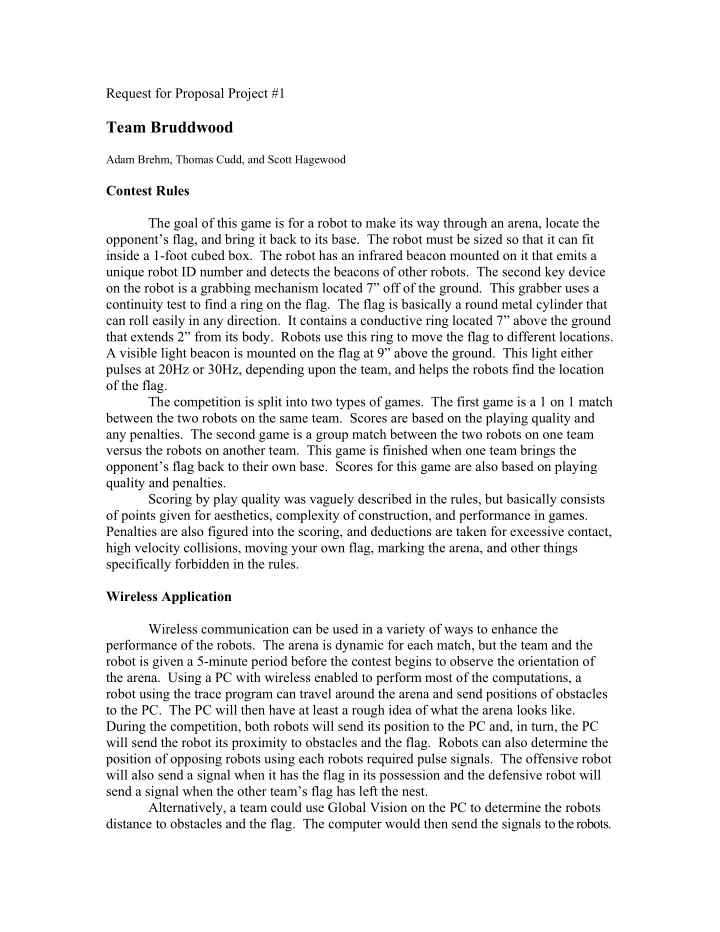

Request for Proposal Project #1 Team Bruddwood Adam Brehm, Thomas Cudd, and Scott Hagewood Contest Rules The goal of this game is for a robot to make its way through an arena, locate the opponent’s flag, and bring it back to its base. The robot must be sized so that it can fit inside a 1-foot cubed box. The robot has an infrared beacon mounted on it that emits a unique robot ID number and detects the beacons of other robots. The second key device on the robot is a grabbing mechanism located 7” off of the ground. This grabber uses a continuity test to find a ring on the flag. The flag is basically a round metal cylinder that can roll easily in any direction. It contains a conductive ring located 7” above the ground that extends 2” from its body. Robots use this ring to move the flag to different locations. A visible light beacon is mounted on the flag at 9” above the ground. This light either pulses at 20Hz or 30Hz, depending upon the team, and helps the robots find the location of the flag. The competition is split into two types of games. The first game is a 1 on 1 match between the two robots on the same team. Scores are based on the playing quality and any penalties. The second game is a group match between the two robots on one team versus the robots on another team. This game is finished when one team brings the opponent’s flag back to their own base. Scores for this game are also based on playing quality and penalties. Scoring by play quality was vaguely described in the rules, but basically consists of points given for aesthetics, complexity of construction, and performance in games. Penalties are also figured into the scoring, and deductions are taken for excessive contact, high velocity collisions, moving your own flag, marking the arena, and other things specifically forbidden in the rules. Wireless Application Wireless communication can be used in a variety of ways to enhance the performance of the robots. The arena is dynamic for each match, but the team and the robot is given a 5-minute period before the contest begins to observe the orientation of the arena. Using a PC with wireless enabled to perform most of the computations, a robot using the trace program can travel around the arena and send positions of obstacles to the PC. The PC will then have at least a rough idea of what the arena looks like. During the competition, both robots will send its position to the PC and, in turn, the PC will send the robot its proximity to obstacles and the flag. Robots can also determine the position of opposing robots using each robots required pulse signals. The offensive robot will also send a signal when it has the flag in its possession and the defensive robot will send a signal when the other team’s flag has left the nest. Alternatively, a team could use Global Vision on the PC to determine the robots distance to obstacles and the flag. The computer would then send the signals to the robots.
Request for Proposal Project #2 Team Bruddwood Adam Brehm, Thomas Cudd, and Scott Hagewood Introduction In addition to a robot project with a wireless application, our group decided to look into the possibilities of creating a circuit using a Field-Programmable Gate Array (FPGA). FPGA's are composed of up to tens of thousands of cells. In each of these cells, there is a logic function such as NAND, OR, or AND. Connections between adjacent cells are hardwired per the user's request. Many software packages available allow the design of these circuits to take place well in advance of burning. FPGA's allow for many possible circuits to be created. Design Ideas Many of the circuit ideas could be broken down into a few major categories. We would create one of these three: • A hardware device to replace an existing software function • An embedded processor that would be within another device • Digital Signal Processing (DSP) function After some research, we decided on an FPGA that would implement some sort of audio compress to be used for data transmission. Most likely, the board we would create would encode .wav files into .mp3 files, thus reducing the size of the original file by upwards of 10 times (depending on sampling rate). Considering the number of people using their hard drives to store the compact disks in mp3 format, this seems to be a useful tool. A computer would not have to use its processing power to spend time encoding files. While Dr. Scott has numerous FPGA's available for student project use, purchasing a board to connect to a PC could cost upwards of $150. Another problem would be that it would be necessary to learn more about the interface between the PC and board, like USB. In addition, the complexity of such a software function could take many weeks to unfold depending on the functionality that we require. Conclusion Overall, the idea of gaining experience with FPGA's would be valuable in many computer engineering jobs; However, a semester to learn such a task may not be feasible. Even though many students have experience with programming microprocessors using an Altera board, or creating circuit diagrams in Xilinx, learning addition items like a parallel or USB interface and learning more about the mp3 codec might be more than can be completed in one semester.
References: RoboFlag contest rules http://www.roboflag.carleton.ca/rules Xilinx DSP function information http://www.xilinx.com/appnotes/dspintro.pdf Andraka Consulting Group, information on FPGA projects http://www.andraka.com/
Recommend
More recommend